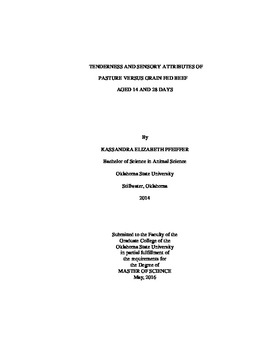| dc.contributor.advisor | Mafi, Gretchen | |
| dc.contributor.author | Pfeiffer, Kassandra | |
| dc.date.accessioned | 2017-02-22T22:16:09Z | |
| dc.date.available | 2017-02-22T22:16:09Z | |
| dc.date.issued | 2016-05-01 | |
| dc.identifier.uri | https://hdl.handle.net/11244/49139 | |
| dc.description.abstract | The objective of this study was to evaluate the effects of different feeding regimes and postmortem aging times on palatability traits. All cattle were on forage diets during the entire stocking period. For finishing, cattle were randomly assigned to either a conventional grain based diet or pasture finished on alfalfa. Conventionally finished cattle were fed for 94 d, and alfalfa cattle were on pasture for either 88 or 130 d. Average age of cattle at slaughter was 18.2 mo for concentrate fed and 18.9 mo for alfalfa finished. Strip loins (n = 107) were cut into 11, 2.54 cm thick steaks and vacuum packaged. The data were analyzed using the Mixed Procedure of SAS. Carcasses from concentrate finished cattle had a higher (P < 0.05) calculated yield grade, higher (P < 0.05) marbling scores, and were (P < 0.05) fatter than pasture fed cattle. There was no difference (P > 0.05) in ribeye area or KPH fat percentage between the feeding regimes. Protein and collagen percentages were not different (P > 0.05) between treatments. Grain fed beef had more fat (P < 0.05) and less moisture (P < 0.05) content than pasture fed beef. When comparing all treatment types, 14 d grain and grass fed steaks had the lowest WBS values. There was an interaction (P < 0.05) between aging and feeding regimes for palatability traits. Grain fed beef, 14 and 28 d, was ranked higher for juiciness than grass fed beef at 14 and 28 d aging. The 28 d grass fed beef samples were rated as the least tender by panelists, while the 28 d grain fed beef samples were ranked as the most tender. Panelists rated grass fed beef to have less beef flavor and more grass off-flavor than grain fed beef at both 14 and 28 d. There was no difference (P > 0.05) in connective tissue amount between the aging and feeding regimes. The results indicate there is no difference in tenderness of grass fed versus grain fed steaks found by instrument; however, trained panelists could detect a difference in tenderness, juiciness, and flavor. | |
| dc.format | application/pdf | |
| dc.language | en_US | |
| dc.rights | Copyright is held by the author who has granted the Oklahoma State University Library the non-exclusive right to share this material in its institutional repository. Contact Digital Library Services at lib-dls@okstate.edu or 405-744-9161 for the permission policy on the use, reproduction or distribution of this material. | |
| dc.title | Tenderness and Sensory Attributes of Pasture Versus Grain Fed Beef Aged 14 and 28 Days | |
| dc.contributor.committeeMember | Vanoverbeke, Deborah | |
| dc.contributor.committeeMember | Ramanathan, Ranjith | |
| osu.filename | Pfeiffer_okstate_0664M_14290.pdf | |
| osu.accesstype | Open Access | |
| dc.description.department | Animal Science | |
| dc.type.genre | Thesis | |
| dc.type.material | text | |
